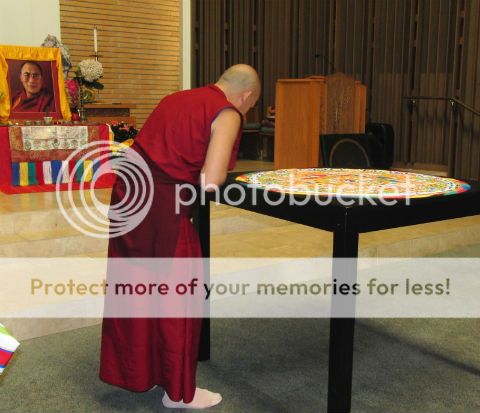




In which Tibetan Buddhist monks created a sand mandala, and then returned it to the sea. (At Neighborhood Congregational Church in Laguna Beach; video here)





In which Tibetan Buddhist monks created a sand mandala, and then returned it to the sea. (At Neighborhood Congregational Church in Laguna Beach; video here)
Comments are closed.
Wow!
My thoughts, exactly!
Gorgeous–and so peaceful.
I was captivated.
You might also enjoy this time-lapse video. The location is different, but it’s the same group of Tibetan Buddhist monks. It shows the entire ritual, beginning to end.
http://www.youtube.com/watch?v=Sr1i5E3GbUA&feature=share
That is amazing and gorgeous!
I learned so much about the monks–and myself!–by observing this ritual firsthand.
It’s ironic, I suppose, that I’ve posted pictures of an event that’s meant to symbolize “the impermanence of all things.” But then again, some people never get to witness this for themselves, so I’m thinking (hoping) there’s benefit in doing just that.
Oh Melodye, this is **EXACTLY** what I needed to see.
Thank you.
((hugs))
I’m so glad that you enjoyed seeing this–and at the perfect time, no less. xoxo
Can I repost one of your photos on Tumblr, crediting you by your LJ name and linking back here? (I’ll understand if the answer is no)
Yes, absolutely. But there’s no need to credit me. I’m honored that you’d want to share it/them.
How interesting…just the whole idea is fascinating.
Lovely. Thanks!
Very happy to share! 🙂
wow—just wow
My thoughts, exactly. I’m in awe of their artwork, and am inspired by its lessons.
How long did it take to make this beautiful work of art?
The one word that comes to mind is “Amazing”.
It took a total of 5 days, beginning with the rituals you’ll see in the video, and ending with the emptying of the sand into the sea.
(So good to “see” you here, Papadan!)
I agree. I think it symbolizes some of the “Middling” concepts you’ve written about, as inspired by Eckhart Tulle.
That literally took my breath away on more than one level. Stunning.
Same here! And yet…I found myself breathing calmer breaths; more deeper, too.
I’m glad I followed the link to the YouTube video of the monks making the sand mandala in San Francisco — it was eye-opening. For some reason — probably having to do with the fact that in the still photos I have seen of this kind of ceremony, there is typically one lone monk working away at the laborious task of making the mandala — I had been led to the belief (now obviously mistaken) that this incredible feat was performed by one individual.
It’s a little less mind-boggling when you realize that it’s actually done by a group (well, at least in this instance), of four or more monks employing tools to help them lay out the precise patterns of the mandala, patterns which are then filled in with the colored sand. I suppose if I had really thought about it, it would make sense that they would use such tools… I guess I was imagining a more superhuman ability to create such patterns freehand.
It’s still very impressive, and I don’t think I could bring myself to create something like that and then destroy it (though perhaps I should try, to see what it feels like).
I really enjoyed the look at the tools they used to “draw” with the sand — those tapered cones filled with sand, and the little rods they use to tap the cones to help the grains of sand flow better.
As I watched the video of the monks crouched over the emerging design, heads bowed close to the table, I wondered: If one of them sneezed powerfully, would they start all over? — PL
I wanted to get a picture of several monks, working together on the mandala, but that was not to be. The entire time I was there, this lone monk worked on a tiny area of the mandala. Total concentration; absolute silence.
I liked learning more about the tools they used, and also about the sand. It’s actually not ocean sand but white river rock, crushed fine by the monks. They grind each stone by hand, using primitive tools, until it it’s very fine. (It’s pictured above, in the bowl.) According to the monks’ escort, when they rub hard and fast on the funnel-shaped brass tubing (chakpur), the sand comes out in a thicker stream. That’s how they get the multi-dimensional mandala you see here.
LOL about the sneezing! I do, in fact, think they’d start over, without (visible) judgment or frustration. That’s well in line with the Buddhist philosophy re impermanence and detachment.